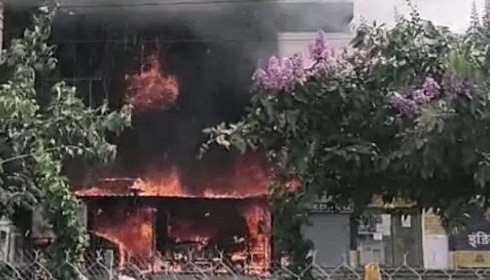
Jabalpur hospital fire: A grim reminder of non-compliance with safety norms
 Rajeev Choudhury
Rajeev Choudhury
The devastating fire that took away eight lives in a private hospital in Jabalpur on August 1, 2022, brings the issue of non-compliance with safety norms in hospitals around the country to the forefront.
The hospital in question, which started possibly functioning in 2020 amid the COVID pandemic, did not have a fire exit or proper fire safety equipment installed, local media reported quoting sources.
According to the Fire Superintendent, the fire broke out on the ground floor due to a short circuit when the generator was switched-on following a power cut around 2:45 pm.
Meanwhile, the Madhya Pradesh Chief Minister, Shivraj Singh Chouhan has ordered a probe into the matter to ascertain the causes.
“The probe will ascertain the reasons behind the blaze and those found responsible for any lapses will have to face the strictest action,” the Chief Minister told the media.
According to available data, between August 2020 and April 2022, at least 122 people have died due to fires in hospitals across the country.
Fires in hospitals are not very uncommon in India and according to a 2020 study published in the International Journal of Community Medicine and Public Health found that between 2010 and 2019, 33 major fires broke out in hospitals across India.
The study further found that as many as 78% of the fires started because of electrical malfunctions, short circuits to be precise, and air-conditioners are the most common source of fire.
In almost a third of the cases, 10 out of 33, the fire broke out near ICU and in what could be a possible eye opener, only 19 of the 33 hospitals had a functional fire fighting system, the researchers of the study reported.
Though the country has adopted the National building code of India that puts hospitals under the C-1 category, requiring the hospital buildings to have the special infrastructure to ensure fire safety, experts say that the norms are rarely followed.
The code stipulates that all areas that house ambulatory patients like operation theatres, delivery rooms, Intensive care units, recovery rooms, etc, should be made of materials that can resist fires for at least 120 minutes.
“Simple measures such as judicious placement of electrical devices (particularly air conditioners) and monitoring equipment in oxygen-rich areas is the need of the hour,” the researchers of the study noted in the paper.
“Safety audits should be conducted on a periodical basis to check the functioning of fire fighting equipment training programs and dissemination of fire preparedness policy among staff members should be given priority,” they added.